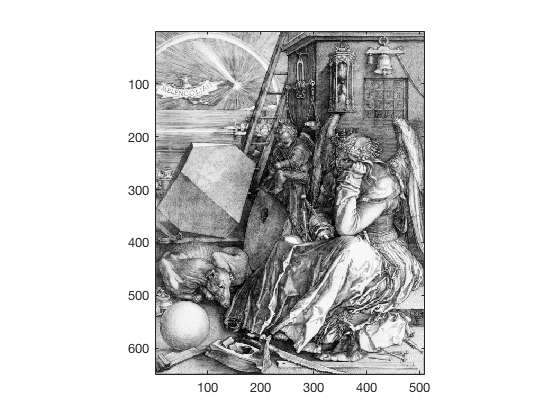Lecture 6: Matrix¶
Date: 09/19/2017, Tuessday
In [1]:
format compact
Matrix operation basics¶
Making a magic square
In [2]:
A = magic(3)
A =
8 1 6
3 5 7
4 9 2
Take transpose
In [3]:
A'
ans =
8 3 4
1 5 9
6 7 2
Rotate by 90 degree. (Not so useful for linear algebra. Could be useful for image processing.)
In [4]:
rot90(A')
ans =
4 9 2
3 5 7
8 1 6
Sum over each column
In [5]:
sum(A)
ans =
15 15 15
Another equivalent way
In [6]:
sum(A, 1)
ans =
15 15 15
Sum over each row
In [7]:
sum(A, 2)
ans =
15
15
15
Extract the diagonal elements.
In [8]:
diag(A)
ans =
8
5
2
The sum of diagonal elements is also 15, by the definition of a magic square.
In [9]:
sum(diag(A))
ans =
15
Determinant
In [10]:
det(A)
ans =
-360
Matrix inversion \(A^{-1}\)
In [11]:
inv(A)
ans =
0.1472 -0.1444 0.0639
-0.0611 0.0222 0.1056
-0.0194 0.1889 -0.1028
Built-in image for magic square¶
In [12]:
load durer
image(X)
colormap(map)
axis image

In [13]:
load detail
image(X)
colormap(map)
axis image

Vector norms¶
In [14]:
x = 1:5 % make a boring vector
x =
1 2 3 4 5
Calculate p-norm from formula
In [15]:
my_norm = @(x,p) (sum(abs(x).^p))^(1/p)
my_norm =
function_handle with value:
@(x,p)(sum(abs(x).^p))^(1/p)
Check if it works.
In [16]:
my_norm(x,1)
ans =
15
As p increases, the norm converges to \(\max(|x|)\)
In [17]:
for p=1:10
my_norm(x,p)
end
ans =
15
ans =
7.4162
ans =
6.0822
ans =
5.5937
ans =
5.3602
ans =
5.2321
ans =
5.1557
ans =
5.1073
ans =
5.0756
ans =
5.0541
It blows up at \(p=442\) because \(5^{442}\) exceeds the
realmin.
In [18]:
my_norm(x,441), my_norm(x,442)
ans =
5
ans =
Inf
In [19]:
5^441
ans =
1.7611e+308
In [20]:
5^442
ans =
Inf
Built-in function norm works for large numbers, though. Think about
why.
In [21]:
norm(x,441), norm(x,442)
ans =
5
ans =
5
Conditioning¶
4x4 magic square
In [22]:
B = magic(4)
B =
16 2 3 13
5 11 10 8
9 7 6 12
4 14 15 1
It is singular and ill-conditioned.
In [23]:
inv(B)
Warning: Matrix is close to singular or badly scaled. Results may be inaccurate. RCOND = 4.625929e-18.
ans =
1.0e+15 *
-0.2649 -0.7948 0.7948 0.2649
-0.7948 -2.3843 2.3843 0.7948
0.7948 2.3843 -2.3843 -0.7948
0.2649 0.7948 -0.7948 -0.2649
In [24]:
det(B)
ans =
5.1337e-13
In [25]:
cond(B)
ans =
4.7133e+17
Use 1-norm instead. All norms should have similar order of magnitude.
In [26]:
cond(B,1)
Warning: Matrix is close to singular or badly scaled. Results may be inaccurate. RCOND = 4.625929e-18.
> In cond (line 46)
ans =
2.1617e+17
The condition number reaches 1/eps, leading to large numerical
error.
In [27]:
1/eps
ans =
4.5036e+15
Sparse matrix¶
In [28]:
A = eye(10)
A =
1 0 0 0 0 0 0 0 0 0
0 1 0 0 0 0 0 0 0 0
0 0 1 0 0 0 0 0 0 0
0 0 0 1 0 0 0 0 0 0
0 0 0 0 1 0 0 0 0 0
0 0 0 0 0 1 0 0 0 0
0 0 0 0 0 0 1 0 0 0
0 0 0 0 0 0 0 1 0 0
0 0 0 0 0 0 0 0 1 0
0 0 0 0 0 0 0 0 0 1
Store it in the sparse form saves memory.
In [29]:
As = sparse(A)
As =
(1,1) 1
(2,2) 1
(3,3) 1
(4,4) 1
(5,5) 1
(6,6) 1
(7,7) 1
(8,8) 1
(9,9) 1
(10,10) 1
Use whos A and whos As to check memory usage.
Visualize sparsity. Also works for As
In [30]:
spy(A)
